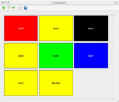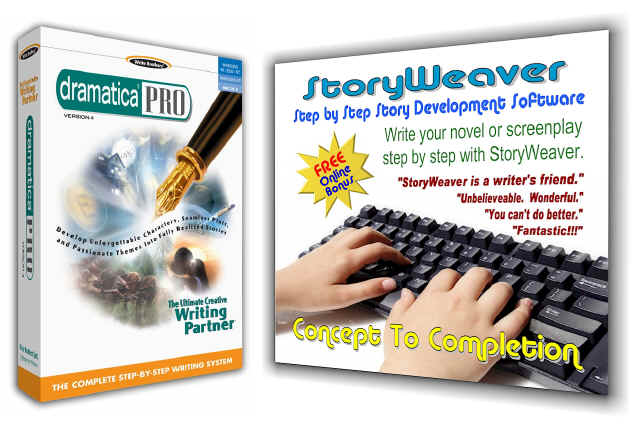|
|
Software |
StoryWeaver
$29.95

A step by
step approach to story development, from concept to completed story for
your novel or screenplay. More than 200 interactive Story Cards guide
you through the entire process.
Details
and Demo
Dramatica
$149.95

The most
powerful story structuring software available, Dramatica is driven by a
patented "Story Engine" that cross-references your dramatic
choices to ensure a perfect structure.
Details
and Demo
Movie
Magic Screenwriter
$149.95

The most
advanced screenwriting software available, Movie Magic is deemed a
"preferred file format" by the Writer's Guild. An industry
standard, MMS is used by professionals and studios around the world.
Details
and Demo
Throughline
Index Cards
$9.95

Interactive
index cards - Name them, add notes, titles, colors, click and drag to
re-arrange, adjust font, save, export and print. An essential tool for
every writer.
Details
Academic
Discounts
on Select Products

Are you a
student, teacher, or academic staffer? Get the very best price on select
products with these manufacturer sponsored academic discounts!
Details

|
| |
Chapter 7
Grouping the 16
Motivation Elements
A Better Way to Group Elements
A better way to organize these characteristics is to separate the Action Elements from
the Decision Elements. Of course, since the Eight Archetypal Character Types describe a
specific pairing of Action characteristic to Decision characteristic, when we separate the
sets, we cannot keep the Archetypal Character names as their contents are split.
Nevertheless, it is much more useful to arrange the Elements by their similar natures
rather than by the simple arrangement contained in the Archetypal Characters.
With 16 characteristics, we can create four quads of four characteristics each. This grows
from having a Driver Character Quad and a Passenger Character Quad, then splitting each in
two (Action Quad and Decision Quad), giving us four Quads: the Action Driver Quad, the
Decision Driver Quad, the Action Passenger Quad, and the Decision Passenger Quad.
Motivation Element Quads

Using the Quads to Gain Meaning
In Dramatica, a group of four Quads is called a Set. Note how the set above provides
additional meaning. For example, when dealing with a problem of Action in terms of
Drivers, one would have the choice to Pursue, Prevent, Help, or Hinder. When a Character
represents the Drive to Pursue, it applies itself to achieving the goal. Although it may
also want the goal to be achieved, a Help Character focuses its efforts on being useful to
the Pursuit of the goal rather than instigating its own effort. This explains the
functions of and relationship between the Protagonist's Drive (Pursue) and the Guardian's
Drive (Help).
Similarly, when a Protagonist's Drive is Pursue, an Antagonist's Drive is Prevent. And, of
course, the Contagonist Hinders the Protagonist's Pursuit. In fact, when we consider all
four Quads, we can obtain a very precise understanding of why the Eight Archetypal
Characters are created as they are and exactly how they relate.
Complex Arrangements of Character Elements
So far we have only explored sixteen different character Elements. One way to create
complex characters is by assigning these sixteen Elements to characters in non-archetypal
patterns. However, as great as the number of potential characters that can be created is,
this limited set of sixteen Elements is still not sufficient to describe all the
rich complexities of the Objective Characters we see in sophisticated stories. This is
because these sixteen Elements only represent character Motivations. In fact, we
call them the Sixteen Motivation Elements.
Characters Do Not Live By Motivations Alone
Like real people, characters are driven by Motivations, but they also aspire to
different Purposes, employ different Methodologies in the effort to achieve
those purposes, and use different Means of Evaluation to determine the
effectiveness of their efforts. The old adage that one should create three
dimensional characters falls short by one dimension. Fully realized characters are four
dimensional possessing an Action and Decision Element in each dimension.
In the following sections we will explore two kinds of character complexity. First we will
look at ways to rearrange the Motivation Elements, and second, we will outline how to
bring the other three character dimensions into play.
Star Wars Characters
in Four Motivation Quads
Once again, to enhance our "feel" for these relationships, let's add the names
of the Characters in Star Wars to the Quads.
Star Wars

As before, the amazingly pure Archetypal Characters of Star Wars
translate into a completely symmetrical pattern. Each Character has an Action Quad
characteristic and a Decision Quad characteristic. Each pair of Characters is in direct
opposition, both internally and externally. Further, Driver Archetypes are represented
exclusively in the Driver Quads, and Passenger Archetypes are found entirely within the
Passenger Quads.
"Oz" Characters
in Four Motivation Quads
The Wizard of Oz

In looking at these patterns, the Passenger Characters in The Wizard of Oz
seem very much like the Passenger Characters in Star Wars, with that one
notable exception of the "flipping" of Logic and Feeling in relation to Control
and Uncontrolled. In other words, the two Characters simply traded places on one Dynamic
Pair of Elements in a single Quad. It makes sense that a stereotypical Reason Character
would be logical AND controlled, and a stereotypical Emotion Character would be feeling
AND uncontrolled. But if you simply flip the Action Characteristics in relation to the
Decision Characteristics, far more versatile Characters are created -- characters whose
approach is no longer in complement to their attitude, but in conflict with
it. In a sense, these Characters are made more interesting by creating an inequity within
them even as they continue to represent methods of problem solving within the Story Mind.
Looking at the Wizard and the Wicked Witch we see that the other kind of swapping of
characteristics also creates much less stereotypical Characters. Rather than a tempter,
the Wicked Witch becomes a completely action-oriented pest not only trying to prevent
Dorothy from achieving her goal, but hindering her every step on the way as well. The
Wizard becomes a purely decision-oriented tempter who represents taking the apparent easy
way out while also (through his fearsome reputation, embodiment, and requests) urging
Dorothy and her friends to reconsider their decisions. This lack of action characteristics
may help explain why the Wizard is so obviously absent during most of the story, although
his influence is felt throughout. Obviously, the nature of the combinations of
characteristics has a great impact on which decisions and actions the audience will expect
and accept from a Character.
Jaws Characters
in Four Motivation Quads
Jaws

Clearly, the Driver Character characteristics in Jaws are as simple as
those in Star Wars. In fact, they are identical in terms of which
characteristics are combined into a single Character. However, when we look at the
Passenger Character characteristics, we see a new phenomenon: some of those Elements are
present in the Driver Characters, two of whom are doing multiple duty.
The Mayor represents Temptation and Hinder as a Driver Character but also represents the
Passenger characteristics of Disbelief and Oppose. Hooper, a Driver in Conscience and
Help, also represents Logic and Uncontrolled, putting him in conflict with Quint. It is
clear that these "multi-characteristic" Characters are much more complex in
their make-up and therefore in their interactions than Archetypes. For this reason we
refer to them as Complex Characters.
How to Order your copy of
Dramatica: A New Theory of Story
Back to the Table of Contents
Back to Home Page
Copyright 1996, Screenplay Systems, Inc.
The Dramatica theory was developed by Melanie Anne Phillips and Chris Huntley
Chief Architect of the Dramatica software is Stephen
Greenfield
Dramatica is a registered trademark of Screenplay Systems Incorporated
Visit
the Dramatica Theory Home Page
Try Dramatica & StoryWeaver Risk
Free*

$179.95
$29.95
*Try either or both for 90 days. Not working for you?
Return for a full refund of your purchase price!
About Dramatica and
StoryWeaver
Hi, I'm Melanie Anne Phillips,
creator of StoryWeaver,
co-creator of Dramatica
and owner of Storymind.com. If you have a moment, I'd like to tell you
about these two story development tools - what each is designed to do, how
each works alone on a different part of story development and how they can be
used together to cover the entire process from concept to completion of your
novel or screenplay.
What They Do
Dramatica is a tool to help you
build a perfect story structure. StoryWeaver is a tool to help you build
your story's world. Dramatica focuses on the underlying logic of your
story, making sure there are no holes or inconsistencies. StoryWeaver
focuses on the creative process, boosting your inspiration and guiding it to add
depth, detail and passion to your story.
How They Do It
Dramatica has the world's only
patented interactive Story Engine™ which cross-references your answers to
questions about your dramatic intent, then finds any weaknesses in your
structure and even suggests the best ways to strengthen them.
StoryWeaver uses a revolutionary new
creative format as you follow more than 200 Story Cards™ step by step through
the story development process. You'll design the people who'll inhabit
your story's world, what happens to them, and what it all means.
How They Work
Together
By itself Dramatic appeals to
structural writers who like to work out all the details of their stories
logically before they write a word. By itself, StoryWeaver appeals to
intuitive writers who like to follow their Muse and develop their stories as
they go.
But, the finished work of a
structural writer can often lack passion, which is where StoryWeaver can help.
And the finished work of an intuitive writer can often lack direction, which is
where Dramatica can help.
So, while each kind of writer will
find one program or the other the most initially appealing, both kinds of
writers can benefit from both programs.
Try Both Programs
Risk Free!
We have a 90
Day Return Policy here at Storymind. Try either or both of these
products and if you aren't completely satisfied we'll cheerfully refund your
purchase price.
Our
Complete Catalog of Products
|

Get
the Writer's Survival Kit Bonus Package
FREE with ANY purchase!
A $300 Value!
|
 |
StoryWeaver
- $29.95
Our
Bestseller! A
step by step approach to story development, from concept to completed
story for your novel or screenplay. More than 200 interactive
Story Cards guide you through the entire process.
|
 |
Dramatica
Pro - $179.95
Includes
2 Exclusive Bonuses! The
most powerful story structuring software available, Dramatica is driven
by a patented "Story Engine" that cross-references your
dramatic choices to ensure a perfect structure.
|
 |
Dramatica
Writer's DreamKit - $49.95
Little
brother to Dramatica Pro, Writer's DreamKit is built around the same
patented Story Engine - it just tracks fewer story points. So, you
develop the same solid story structure, just with fewer details.
Perfect for beginning writers or those new to Dramatica.
|
 |
Power
Structure - $149.95
An
all-in-one writing environment with built-in word processor that helps
you organize and cross-reference your story development materials.
INCLUDES DVD SET BONUS!
|
|

|
Power
Writer - $99.95
The little
brother of Power Structure includes the essential organization and word
processing tools writers need the most.
|
 |
Throughline
- Index Cards (Mac) - $19.95
Interactive
index cards - add notes, titles, colors, click and drag to re-arrange.
An essential tool for every writer.
|
 |
Movie
Magic Screenwriter - $149.95
The most
advanced screenwriting software available, Movie Magic is deemed a
"preferred file format" by the Writer's Guild. An
industry standard, MMS is used by professionals and studios around the
world.
|
|

|
Final
Draft - $199.95
Like Movie
Magic Screenwriter, Final Draft is an industry standard, used by many
professional screenwriters and studios around the world.
|
 |
Between
The Lines (Macintosh) - $29.95
The lowest
cost automatic screenplay formatter for Macintosh includes high-end
features such as interactive index cards linked to your script.
|
|

|
 |
12
Hour Writing Course - $19.95
Everything
you need to know about story structure - twelve hours of video on a
single DVD - presented by Dramatica Theory co-creator, Melanie Anne
Phillips.
|
 |
Dramatica
Software Companion - $19.95
More than
four hours of video demonstrations of every key feature in Dramatica,
narrated by the co-creator of Dramatica.
|
 |
StoryWeaving
Tips Book - $19.95
170 pages of
eye-opening essays on story structure, storytelling, finding inspiration
and a wide variety of writing techniques.
|
 |
StoryWeaving
Seminar 8 DVD Set - $99.95
14 hours of
video from a live two day course taught by theory co-creator Melanie
Anne Phillips covering Dramatica story structure and StoryWeaver
storytelling.
|
 |
StoryWeaving
Seminar Online - $49.95
The same 14
hour program presented in streaming video that you can view online or
download for a permanent copy.
|
 |
Dramatica
Theory 2 Hour Audio Program - $19.95
Every key
concept in the Dramatica Theory of Story is fully explained in this
double-CD set.
|
|

|
Writing
Characters of the Opposite Sex - $29.95
A three-hour
audio CD set that explains everything you need to know to create
characters of both sexes that ring absolutely true (and maybe even gain
insight into the communication problems in the real world!)
|
 |
Master
Storyteller Improves Your Writing - $29.95
Become a
better writing with this series of interactive exercises.
|
|

|
How
to Create Great Characters DVD - $19.95
A 90 minute
video program recorded during Dramatica co-creator Melanie Anne
Phillips' live in-person seminar on story structure and storytelling.
|
|

|
Structure
vs. Passion - Audio CD $19.95
The Story
Mind approach to writing uses your own passions to create your story's
structure. It focuses your efforts, clarifies the direction of
your story, and triggers your imagination.
|
|

|
Writing
with the Story Mind - Audio CD - $19.95
Learn how to
psychoanalyze your story's "mind" to uncover and treat
problems with characters, plot, theme, and genre.
|
|

|
|

|
Academic
Prices - Discounts on Select Products
Are you a
student, teacher, or academic staffer? Get the very best price on
select products with these manufacturer sponsored academic discounts!
|
|

|
Package
Deals - Starting at $49.95
Get deep
discounts with these bundles of our most popular writing products.
|
|

|
Writer's
Survival Kit Bonus Package - FREE!
Free with
ANY purchase - Writing software, online writing workshops, writing
seminars on video, story theory book, and much, MUCH more!
|
| |
|
